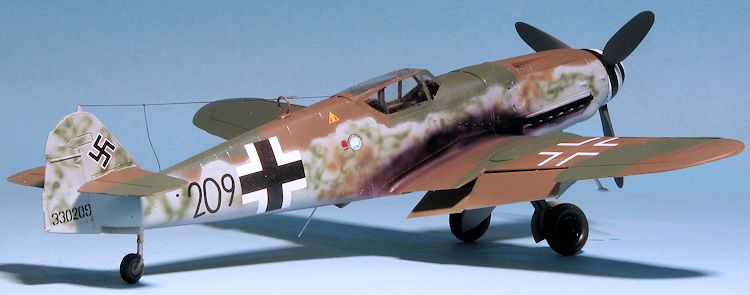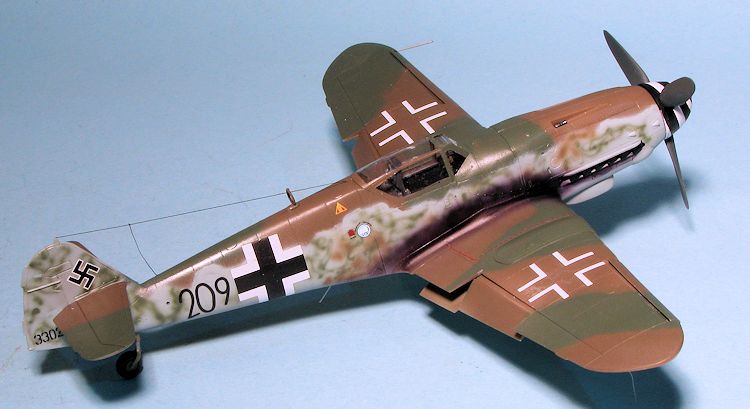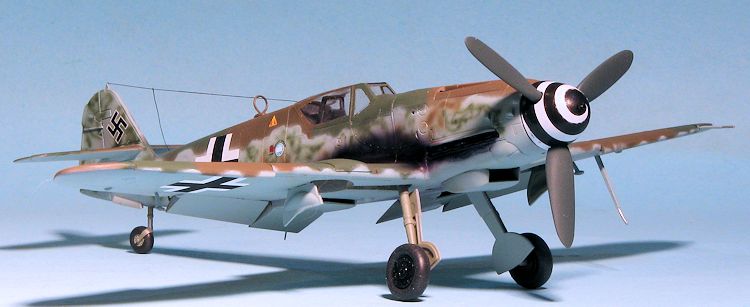
| KIT #: | 09063 |
| PRICE: | $24.95 SRP when new |
| DECALS: | Two options |
| REVIEWER: | Scott Van Aken |
| NOTES: | Standard boxing from 1999 |

| HISTORY |
The final Bf-109 variant to be built was the K model. It took
all of the improvements of the G series and combined them into a single
airframe. Gone were the bulged cannon feed covers; replaced by a smoother
cowling. Also incorporated into this variant was a fully retractable tail wheel
and the inclusion of outer gear doors, a modification that was planned for the G
series but never incorporated. The K also had the taller tail wheel and the
taller fin and rudder that had been applied to later versions. Also standard was
the Erla Haube canopy that was standard on the G-1 0 and later G-14 versions.
Similar to the G-10 and some G-14s, the K-4 had the wider wheels that required
wide fairings on the upper wing.
0 and later G-14 versions.
Similar to the G-10 and some G-14s, the K-4 had the wider wheels that required
wide fairings on the upper wing.
All K models were new built airframes and production commenced in late summer of 1944. Actually the planned start-up of the K model was mid 1943, but events (such as a lack of engines and work on the Me-209 and 309) were such that this never occurred. The DB 605D engine was more powerful and as such, consumed more fuel than the earlier versions so range was actually less than the earlier G models. This wasn't really a problem by this time in the war as the Reich was slowly shrinking. Thanks to the relocation of some systems, such as the MW 50 injection system, the balance of the plane was improved to similar to the F models, an aircraft that most 109 pilots have said was the best flying of the lot. A number of aircraft had the outer gear doors removed and the tail wheel fixed in the lowered position.
| THE KIT |
This is very similar to other Hasegawa 109s in that there are several common sprues along with some that are specific to the variant being kitted. In this case it has a new clear sprue, fuselage sprue, tailplanes and some other bits that are specific to this version. The other sprues with the wings and such are the same in all 109F/G/K kits.
 The same options offered in the other 109s regarding the positions of the
radiator exhaust flaps, the slats and the flaps also pertain to the K. You can
also display the canopy open, should you desire. One glitch in the Hasegawa kit
regards the tail wheel doors. As you can see from the image, the doors are
molded open. Not sure just where they got this bit of info from, but the doors
were fully closed except when undergoing maintenance or while cycling through
the retraction sequence. You'll have to cut them off and reposition them fully
closed.
The same options offered in the other 109s regarding the positions of the
radiator exhaust flaps, the slats and the flaps also pertain to the K. You can
also display the canopy open, should you desire. One glitch in the Hasegawa kit
regards the tail wheel doors. As you can see from the image, the doors are
molded open. Not sure just where they got this bit of info from, but the doors
were fully closed except when undergoing maintenance or while cycling through
the retraction sequence. You'll have to cut them off and reposition them fully
closed.
As a note on the tail wheel doors; I've been contacted by a number of
readers who state that these doors were operated by a simple mechanical latch
that opened them when the tail wheel extended and closed them when it retracted.
This means that they should be open when on the ground. However, looking through
a rather large number of period photos of 109Ks, I found very few images of
these doors open.
 That leads me to believe that the retraction mechanism for the
tail gear was disabled and the doors simply triggered to stay in the closed
position. The key is
to check your references for the aircraft that you are modeling.
That leads me to believe that the retraction mechanism for the
tail gear was disabled and the doors simply triggered to stay in the closed
position. The key is
to check your references for the aircraft that you are modeling.
The decal sheet contains markings for two aircraft. One is the box art aircraft from II./JG 3 in March 1945. The other is from II./JG 27 around the same time and is in RLM 81/83/76 with a green Reich Defense band around the rear fuselage. The decals are typical of Hasegawa and would best be replaced by an aftermarket sheet of some sort. Fortunately, there are a lot of 109K options out there. If you are really wanting more info that you can handle on Bf-109K camouflage, I can highly recommend the JaPo book "Messerschmitt Bf-109K Camouflage and Markings". It is a real wealth of information and will help a great deal when it comes to painting this kit.
| CONSTRUCTION |
Interestingly, the only reason I decided to build this kit is that I had some RLM 81/82 paint already mixed and ready to go from an earlier Luftwaffe build so figured I'd do this one and use the paint!
I decided to build this one to out of the box rules. This limits what can be done to things like thinning parts, adding seat harness and radio wires. Not an issue as that is how I do many of my kit builds. It did, however, mean that my aftermarket resin cockpits would have to wait another day, and while the kit offering is nice, a resin replacement is even better.
 The first step on this one is to see what needs drilled out
and what needs filled. There are vents on the lower center wing that need filled
and new panel lines need to be scribed on each upper wing. Apparently Hasegawa
feels the 109K never carried a drop tank so you are not told to open up the
holes for it. When I went to research this, I found several dozen period photos
of 109Ks, and most of them that were still on their gear, did not have drop
tanks, though some did. Your choice. I chose a clean airframe so filled in the
area recommended.
The first step on this one is to see what needs drilled out
and what needs filled. There are vents on the lower center wing that need filled
and new panel lines need to be scribed on each upper wing. Apparently Hasegawa
feels the 109K never carried a drop tank so you are not told to open up the
holes for it. When I went to research this, I found several dozen period photos
of 109Ks, and most of them that were still on their gear, did not have drop
tanks, though some did. Your choice. I chose a clean airframe so filled in the
area recommended.
As with most of my kit builds, I built subassemblies first. In this case it means the cockpit, the wings and the fuselage. Yep, you can install the cockpit from the underside so go ahead and glue away. When doing the wings, do not forget to install the radiators before gluing the upper sections. I did a pretty straight stock cockpit doing little more than putting the decal on the instrument panel and drybrushing when everything was painted. One thing I did add were Eduard belts as seat belts are the one aftermarket bit that can be added in out of the box rules.
After the cockpit was installed, I attached the lower wing. Fit is actually fairly good though I did a a small issue with a step on the front where it met the fuselage. A bit of coarse sandpaper will alleviate that. I also used some filler at the wing roots as there is a tad bit of a gap where these join the fuselage. Next the upper radiator flaps were glued on level with the rest of the wing. I also attached the tailplanes and the supercharger intake. The upper cowling is a superb fit needing no filler at all. For this variant, the guns can be added in later, making painting so much easier.
The canopy and windscreen were masked and attached. A hole was drilled for the DF loop antenna, the slats tacked in place, and the airframe was ready for paint.
| COLORS & MARKINGS |
I have quite a few 109K-4 decal sheets so picking one
was not easy. One thing that was a requirement was that it be painted in RLM
81/82/76 as I had those paints already mixed from doing a recent Hasegawa 1/72
FW-190A-8. I settled on Aeromaster 48-492 'Last of the Breed part 1'. In there
was a factory fresh aircraft
 in the colors I required. This plane was delivered
to the Italian ANR in February 1945. I have always wanted to do a plane with
part of the serial painted on the aft fuselage and this gave me the opportunity
to do so.
in the colors I required. This plane was delivered
to the Italian ANR in February 1945. I have always wanted to do a plane with
part of the serial painted on the aft fuselage and this gave me the opportunity
to do so.
The paint was thinned to nearly water consistency, the air pressure reduced to about 7 psi and the camouflage colors and scheme were painted on. Those who model Luftwaffe aircraft find this to be the most fun part of the build. It doesn't take all that long to do compared to the rest of the build, but at least in my case, is the most enjoyable feature of the process.
Once all the paint was in place to my liking, I returned to the work bench to install the main gear legs and the tail gear. With that accomplished, I gave the airframe a couple of coats of clear gloss acrylic (in this case Future) in preparation for the decals. The sheet in question was printed in January 2000 by Cartograf. The markings went on with out any traumas, though they did take an age to come free from the backing paper.
| FINAL CONSTRUCTION |
 There always seems to be a lot of bits to add after
decals. In this case it was the main wheels, main gear doors, exhaust and
shields, aileron balances, Morane antenna, pitot tube, prop/spinner and the nose
guns. The slats were also pulled up and glued permanently. This was followed by
some detail painting and a return to the paint shop to spray on some Alclad II
transparent smoke for the exhaust. Late war fuel was very carbon rich and soon
stained the fuselage. I then drilled a small hole in the upper fuselage to
accept the radio long wire and used EZ Line for this purpose. Note that the aft
fuselage feed line is farther aft than on other variants. The lower short wire
antenna was made using a short length of stretched sprue. The masking
was removed and that was it.
There always seems to be a lot of bits to add after
decals. In this case it was the main wheels, main gear doors, exhaust and
shields, aileron balances, Morane antenna, pitot tube, prop/spinner and the nose
guns. The slats were also pulled up and glued permanently. This was followed by
some detail painting and a return to the paint shop to spray on some Alclad II
transparent smoke for the exhaust. Late war fuel was very carbon rich and soon
stained the fuselage. I then drilled a small hole in the upper fuselage to
accept the radio long wire and used EZ Line for this purpose. Note that the aft
fuselage feed line is farther aft than on other variants. The lower short wire
antenna was made using a short length of stretched sprue. The masking
was removed and that was it.
| CONCLUSIONS |
To my mind, the Hasegawa 1/48 109s are still the best around. They have enough detail for most builders, can usually be found second hand at a decent price and have stood the test of time. In terms of the late war 109s, it is either Hasegawa or Hobbycraft/Academy and while the latter are not bad, they are very much a step below the Hasegawa kits. While Eduard has dabbled into the genre, their initial offering was less than spectacular and it remains to be seen if they will correct the various errors and return to the fray.
March 2015
Thanks to me for the review kit.
If you would like your product reviewed fairly and fairly quickly, please contact the editor or see other details in the Note to Contributors.